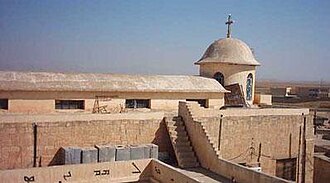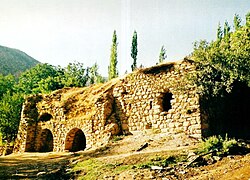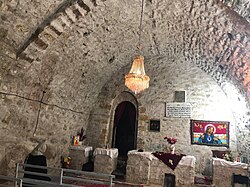Assyrian Church of the East
The Assyrian Church of the East, officially known as the Holy Apostolic Catholic Assyrian Church of the East,[1] is an Eastern Syriac Christian church. It is one of the earliest churches to separate from the larger church. It traces its origins to the Episcopal See of Seleucia-Ctesiphon, which was started by Saint Thomas the Apostle, as well as Saint Mari and Addai (Thaddeus of Edessa), as shown in the Doctrine of Addai. The church is sometimes known as the "Nestorian Church", the "Syrian Church" or the "Persian Church" and is currently headed by Mar Awa III.
| Holy Apostolic Catholic Assyrian Church of the East | |
|---|---|
| ܥܕܬܐ ܕܡܕܢܚܐ ܕܐܬܘܪܝܐ | |
 | |
| Abbreviation | ACOE |
| Classification | Eastern Christian |
| Orientation | Syriac Christian |
| Catholicos-Patriarch | Mar Awa III |
| Absorbed | Chaldean Syrian Church |
| Separations | Chaldean Catholic Church |
| Members | 400,000+ |
Other names have been given as well, but they are not accurate. One of then is Assyrian Orthodox Church, which has led some people to believe that it is part of the Oriental Orthodox community. The church itself does not use the word "Orthodox" in any of its service books or in any of its official correspondence, and it uses no word that can be translated as "correct faith" or "correct doctrine", the rough translation of the word "orthodox". In India, the church is known as the Chaldean Syrian Church. In the West, it is often known as the Nestorian Church. The church itself believes that the term "Nestorian Church" is incorrect.
The Assyrian Church is the original Christian church in what was once Parthia: eastern Iraq and Iran. Geographically, its influence stretched to China and India in the Middle Ages. A monument found in Xi'an (Hsi-an, originally Chang'an), the Tang dynasty's capital of China, in Chinese and Syriac described the activities of the church in the 7th and the 8th century, and half a millennium later, a Chinese monk went from Beijing to Paris and Rome to call for an alliance with the Mongols against the Mamluks.
Before the Portuguese arrived in India in 1498, they provided "East Syrian" bishops to the Saint Thomas Christians. Patriarch Timothy I (727–823) wrote of the large Christian community in Tibet.
The creators of Assyrian theology are Diodorus of Tarsus and Theodore of Mopsuestia. Both taught at Antioch. The standard Christology of the Assyrian Church was written by Babai the Great (551–628) and is clearly different from the accusations of dualism that were directed toward Nestorius. Babai's main Christological work is "Book of the Union" and teaches that the two qnome (Syriac for essences) are unmingled but everlastingly-united in the one parsopa (person) of Christ.

Assyrian Church Of The East Media
Mar Toma church near Urmia, Iran
St. Mary Assyrian Church in Moscow. In spite of both ethnic and religious persecution and a serious decline in membership since its height around the fourth century, the Assyrian Church of the East has survived into the 21st century.
Mar Gewargis Assyrian Cathedral in Chicago: Former Patriarchal See
Mar Narsai Church in Nohadra
Saint Mary Church: an ancient Assyrian church located in the city of Urmia, West Azerbaijan province, Iran
Residence of the Patriarch in Qudshanis, Ottoman Empire (1692–1918).
References
- ↑ Binns, John (4 July 2002). An Introduction to the Christian Orthodox Churches. p. 28. ISBN 9780521667388.
Other websites
| Wikimedia Commons has media related to Lua error in Module:Commons_link at line 62: attempt to index field 'wikibase' (a nil value).. |










